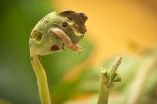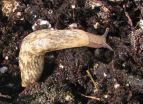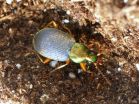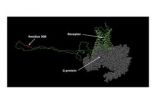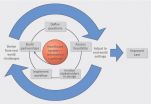INFORMATION:
The USDA's Northeast Sustainable Agriculture Research and Extension program, the Pennsylvania Department of Agriculture and the Maryland Grain Producers Utilization Board supported this work.
Also working on this project was Jason Rohr, associate professor of integrative biology, University of South Florida.
Insecticides foster 'toxic' slugs, reduce crop yields
2014-12-04
(Press-News.org) Insecticides aimed at controlling early-season crop pests, such as soil-dwelling grubs and maggots, can increase slug populations, thus reducing crop yields, according to researchers at Penn State and the University of South Florida.
"Neonicotinoids are the most widely used insecticides in the world," said Margaret Douglas, graduate student in entomology, Penn State. "Seed applications of neonicotinoids are often viewed as cheap insurance against pest problems, but our results suggest that they can sometimes worsen pest problems and should be used with care."
According to John Tooker, associate professor of entomology, Penn State, recent research links neonicotinoids with negative effects on pollinators and pollution of surface water in agricultural ecosystems, and even with cascading negative effects on aquatic invertebrates and insect-eating birds. However, the effects of these common seed-applied insecticides on soil-dwelling creatures have been little explored.
"Our research suggests that neonicotinoids can have unintended costs, even within crop production," he said.
The researchers conducted laboratory and field experiments. In the lab, they exposed slugs to three types of soybeans -- untreated soybeans, soybeans whose seeds were treated with fungicide, and soybeans treated with fungicide and seed-applied thiamethoxam, a very common neonicotinoid. The team then tracked slug weight and survival. Next, the scientists presented slugs from the treatments to a ground beetle species that eats slugs. They then tracked slug mortality and symptoms of beetle poisoning.
In a separate field experiment, the researchers planted quarter-acre plots with soybean seeds that were either untreated or treated with a neonicotinoid. In the plots, the team tracked crop establishment and growth, slug and predator populations, and predation. The scientists submitted samples from their laboratory and field experiments to an analytical laboratory to measure levels of neonicotinoids in soil, plants, slugs and beetles.
The results will appear in the December issue of the Journal of Applied Ecology.
"In our lab work, we found that slugs were unaffected by the fungicides and also unaffected by the neonicotinoid insecticides, likely because they are mollusks and not insects," said Tooker. "But the slugs did transmit the insecticide to the ground beetles, impairing or killing more than 60 percent of the beetles."
In the field, the team found that the neonicotinoid treatments depressed activity of insect predators, thereby relaxing predation of slugs and reducing soybean densities by 19 percent and crop yield by 5 percent.
"Slugs are among the most challenging pests faced by Mid-Atlantic no-till growers," said Tooker. "Our research reveals that neonicotinoids can indirectly increase slug damage to crops by poisoning insects that eat slugs. As a result, crop yields are lower."
According to Tooker, their results also confirm that predatory insects can provide significant control of slugs.
"This phenomenon dispels the common belief in the United States that insect predators do not contribute to slug control," he said. "It also emphasizes that if growers care for these predator populations they can help with slug control."
ELSE PRESS RELEASES FROM THIS DATE:
Higher birth weight indicates better performance in school
2014-12-04
GAINESVILLE, Fla. -- It's no secret that low-birth-weight babies face significantly greater risks for certain health problems early on, such as respiratory distress or infection. Now, a new study from researchers at the University of Florida and Northwestern University shows that lower weights at birth also have an adverse effect on children's performance in school, which is likely due to the early health struggles small babies often face.
Using a unique set of data that matched birth and school records from 1.6 million children born in Florida between 1992 and 2002, ...
Nalmefene for alcohol dependence: Added benefit not proven
2014-12-04
Nalmefene (trade name Selincro) has been approved since February 2013 for people with alcohol dependence who currently drink a lot of alcohol, but who do not have physical withdrawal symptoms and who do not require immediate detoxification. The German Institute for Quality and Efficiency in Health Care (IQWiG) examined in a dossier assessment whether the drug offers an added benefit over the appropriate comparator therapy in this patient group.
According to the findings, such an added benefit is not proven: In its dossier, the drug manufacturer only presented data for ...
AU professor constructs model of receptor protein linked to human growth
2014-12-04
A study published in the New England Journal of Medicine reveals the role of a receptor protein derived from a gene that has been linked to human growth. Co-author Stefano Costanzi, Ph.D., an assistant professor of biochemistry at American University, developed the three-dimensional computer model of the receptor that appears in the study.
"As the study reveals the receptor's role in growth, it may ultimately lead to the development of drugs to treat those affected with conditions that alter growth, such as gigantism or dwarfism," Costanzi said. "The construction of the ...
Pulsars with black holes could hold the 'holy grail' of gravity
2014-12-04
The intermittent light emitted by pulsars, the most precise timekeepers in the universe, allows scientists to verify Einstein's theory of relativity, especially when these objects are paired up with another neutron star or white dwarf that interferes with their gravity. However, this theory could be analysed much more effectively if a pulsar with a black hole were found, except in two particular cases, according to researchers from Spain and India.
Pulsars are very dense neutron stars that are the size of a city (their radius approaches ten kilometres), which, like lighthouses ...
UT Dallas engineer applies robot control theory to improve prosthetic legs
2014-12-04
A University of Texas at Dallas professor applied robot control theory to enable powered prosthetics to dynamically respond to the wearer's environment and help amputees walk.
In research available online and in an upcoming print issue of IEEE Transactions on Robotics, wearers of the robotic leg could walk on a moving treadmill almost as fast as an able-bodied person.
"We borrowed from robot control theory to create a simple, effective new way to analyze the human gait cycle," said Dr. Robert Gregg, a faculty member in the Erik Jonsson School of Engineering and Computer ...
Recommendations against mother-infant bedsharing interfere with breastfeeding
2014-12-04
New Rochelle, NY, December 4, 2014--Recommendations by physician groups to avoid bedsharing among mothers and their babies are intended to reduce sleep-related infant deaths. But evidence suggests that the risks of bedsharing have been over-emphasized, advice never to bedshare is unrealistic, and avoiding bedsharing may interfere with breastfeeding, according to an article in Breastfeeding Medicine, the official journal of the Academy of Breastfeeding Medicine published by Mary Ann Liebert, Inc., publishers. The article is available free on the Breastfeeding Medicine website ...
Living African group discovered to be the most populous humans over the last 150,000 years
2014-12-04
New genetic research reveals that a small group of hunger-gatherers now living in Southern Africa once was so large that it comprised the majority of living humans during most of the past 150,000 years. Only during the last 22,000 years have the other African ethnicities, including the ones giving rise to Europeans and Asians, become vastly most numerous. Now the Khoisan (who sometimes call themselves Bushmen) number about 100,000 individuals, while the rest of humanity numbers 7 billion. Their lives and ways have remained unaltered for hundreds of generations, with only ...
How to create and sustain clinical-research partnerships
2014-12-04
SEATTLE--Pragmatic clinical trials--real-life tests done in real-world settings--are increasingly important for answering pressing questions about how best to deliver health care. But these pragmatic trials require close collaboration between two professional groups who often have contrasting styles. One group is researchers, who follow structure like classical musicians. The other is and health care providers and administrators, who may need to improvise like jazz musicians. How in the world can such disparate players make beautiful music together?
"The key is not just ...
Medical schools have ethical obligation to accept undocumented immigrants
2014-12-04
MAYWOOD, Il. - Medical schools have an ethical obligation to change admission policies in order to accept applications from undocumented immigrants known as Dreamers, according to an article in the December, 2014 issue of the journal Academic Medicine.
Not allowing Dreamers to apply to medical school "represents a kind of unjustified discrimination and violates the basic ethical principle of the equality of human beings," write co-authors Mark G. Kuczewski, PhD and Linda Brubaker, MD, MS of Loyola University Chicago Stritch of Medicine. Academic Medicine is the journal ...
Research could improve nuclear power plant safety -- and stop your kettle furring up
2014-12-04
Taking inspiration from nature, researchers have created a versatile model to predict how stalagmite-like structures form in nuclear processing plants - as well as how lime scale builds up in kettles.
"It's a wonderful example of how complex mathematical models can have everyday applications," said Dr Duncan Borman, from the School of Civil Engineering at the University of Leeds, a co-author of the study.
The main aim of the research, which is published in print today in the journal Computers & Chemical Engineering, is to reduce the number of potentially harmful manual ...
